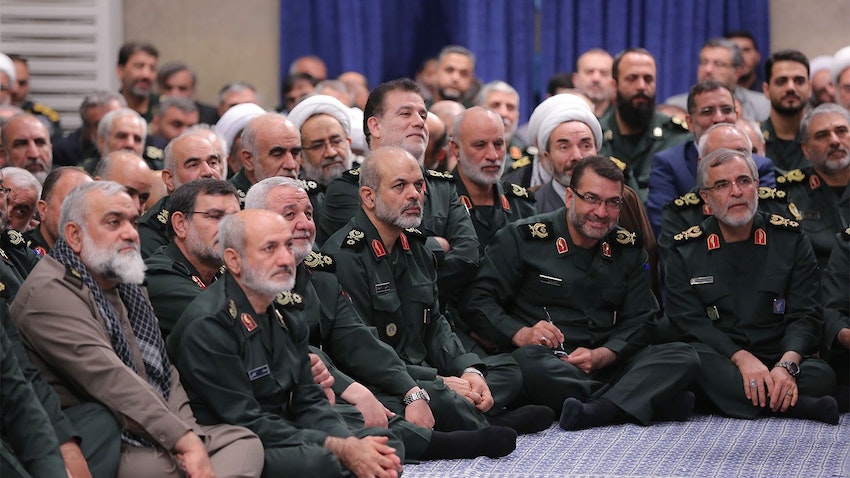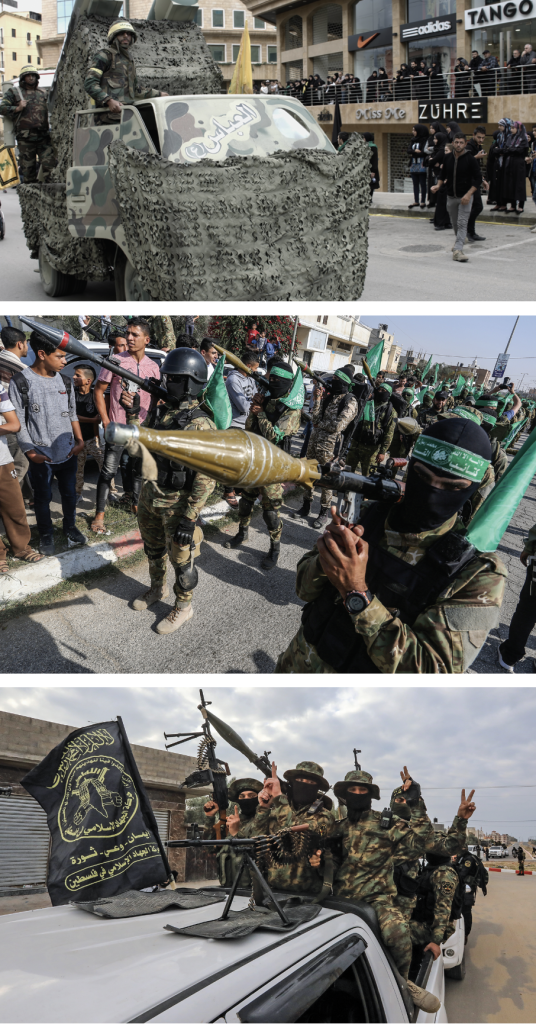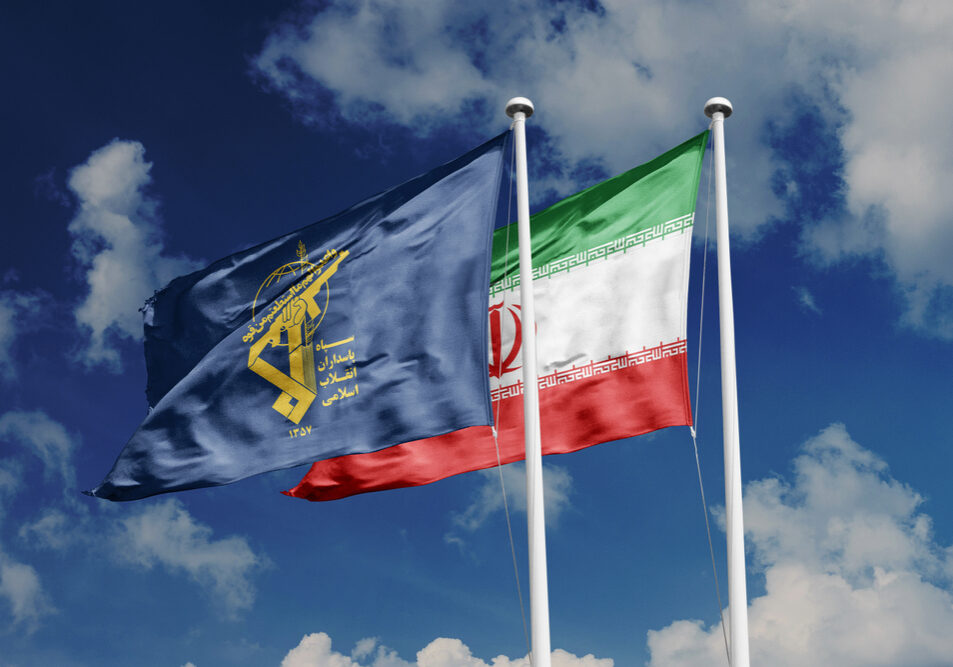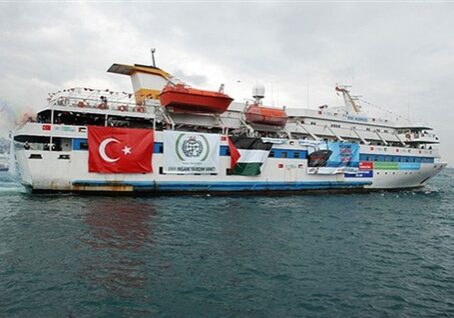Australia/Israel Review
Essay: A New Multifront Strategy?
May 25, 2023 | Oved Lobel

Coordinated IRGC proxy war against Israel is decades old
Hamas for the first time allegedly fired a large salvo of rockets from Lebanon in April 2023 – to coincide with rockets also being launched from Syria and Gaza. All of these attacks were coordinated by Iran’s Islamic Revolutionary Guard Corps (IRGC) Qods Force commander Esmail Qaani, who had been meeting with Hamas, Palestinian Islamic Jihad (PIJ) and the IRGC’s Lebanese subsidiary Hezbollah in Beirut, as well as other proxies across the region, to coordinate attacks against Israel. Shortly thereafter, Israeli Defence Minister Yoav Gallant warned that “this is the end of the era of limited conflicts,” and that Israel now faces an era of multifront war with the IRGC and its front groups, proxies and client states – a network known collectively as the “Resistance Axis” – due to a “convergence of the arenas” overseen by Iran.
And indeed, given the expanding size and sophistication of the Resistance Axis’ missile arsenals ringing Israel and the IRGC’s virtual control of both Iraq and Yemen and consolidation of power in Syria over the past decade, a multifront war could in theory represent a strategic nightmare for Israel. The recent report of Qaani meeting all the Resistance Axis elements to increase and coordinate attacks against Israel, along with intelligence that a “nerve centre” has been established in Beirut to help the IRGC, Hezbollah, Hamas, PIJ, and other groups work together, further fuels Israeli anxiety.
AIJAC has published articles previously (for instance in June 2021) on how the IRGC has been attempting to coordinate a “Resistance Axis” war on Israel from all fronts – Gaza, the West Bank, Lebanon, Syria and even Iraq and Yemen – including boasts by Axis representatives about how close coordination has been since at least 2018.
However, what appears at first glance to represent a relatively new “convergence of arenas” strategy by the IRGC needs to be contextualised as part of the perennial Iranian strategy for waging war on Israel in place since the 1980s, one Israel has managed to counter very successfully to date.

(From top) Hezbollah, Hamas, Palestinian Islamic Jihad: Iranian proxies that are key to implementing Tehran’s multifront strategy (Images: Shutterstock)
1970s-1990s
An inextricably linked Iran-Syria-Palestinian axis has actually been in existence since the early 1970s, with Lebanon the geographical fulcrum of the relationship and Damascus serving as the primary operational headquarters. Lebanon, from the 1980s until 2005, was under the direct military control of Syria, which itself slowly transformed from an ally to a client of the IRGC following the collapse of the Soviet Union. The nexus between Damascus, Beirut and the Palestinian territories should therefore always have been viewed as one front, both geographically and operationally. It’s clear that the multifront war strategy was already in operation during the first intifada years, from 1987-93.
The IRGC and Syria were already deeply involved throughout the 1980s in attacks inside Israel, the West Bank and Gaza and had local agents and groups, such as the former imam of the al-Aqsa Mosque Sheikh Assad Bayoud al-Tamimi, the leader of his own Khomeinist Islamic Jihad faction, operating throughout. To a large degree, PIJ, an Iranian proxy, and the Popular Front for the Liberation of Palestine – General Command (PFLP-GC), a Syrian proxy force, catalysed, inspired and spearheaded the terrorist element of the first intifada, alongside Hamas.
The Resistance Axis coalesced further when the PIJ leadership – already ideologically Khomeinist – was deported by Israel to Lebanon in 1988 and the group then subsumed into the IRGC command structure via Hezbollah, which is better regarded as the IRGC’s Lebanese branch than a truly independent entity or even proxy. It is no coincidence that the first Palestinian suicide attack in Israel was conducted a year later by an Islamic Jihad faction that called itself Palestinian Hezbollah. As Meir Hatina has documented, PIJ and Hezbollah began launching joint operations into Israel and releasing joint communiques after those deportations.
In late 1991, this axis was formalised during a conference held under Iranian auspices to coordinate the intifada and obstruct nascent Israeli-PLO peace talks. According to a 1992 US terrorism report, Iran “hosted a series of high-profile meetings with [Hezbollah] and HAMAS with the stated goal of coordinating their efforts against Israel… In the aftermath of these talks, [Hezbollah] increased its operations against Israel, including its repeated use of rockets to attack villages in northern Israel.” Other Iranian meetings with these Resistance Axis branches to coordinate attacks are noted in reports thereafter.
In 1992, Israel deported hundreds of Islamic Jihad and Hamas operatives and leaders from the West Bank and Gaza to Lebanon, allowing for further integration of Hamas into the axis.
Already in 1992, Syria-controlled Lebanon hosted basing and training infrastructure for multiple groups, including Hamas, PIJ and the PFLP-GC, all of which also had headquarters in Damascus that were overseen by the IRGC. To Israel’s south, Iran also integrated PIJ and Hamas, among others, into the IRGC in Sudan in 1991, with Khartoum acting as a logistics hub and sanctuary like Damascus. The transshipment route for Iranian missiles and other weapons from Sudan to Gaza is well-known and forced Israel to target such shipments and relevant sites in Sudan several times between 2009 and 2014.
That Iranian-organised conference in 1991, the first of many, also established the “Damascus 10” – an alliance of ten Palestinian factions that rejected any peace process with Israel. According to former Hamas spokesperson and senior official Ibrahim Ghosheh, he spoke to then Hezbollah Secretary-General Abbas al-Musawi at the conference and coordinated Hezbollah attacks from Lebanon in support of the intifada. Further important meetings between Hamas and the Iranian regime were held in 1999 and 2000, while the IRGC constantly met with its agents in Damascus to encourage coordinated attacks on Israel.
For some reason, Hezbollah’s guerilla war against Israel in Lebanon in the 1980s-1990s was and often still is viewed as a separate phenomenon to the first intifada, when they were in fact two fronts in the same battle.
2000s
Israel opted for a perilous unconditional withdrawal from Lebanon in May 2000, which Hamas’ Ghosheh asserts was a “direct factor” in precipitating the start of the Second Intifada later that same year. This one was largely run by the Resistance Axis, not only in terms of financial and logistical support, but direct orders and action. Hezbollah restarted substantial attacks against Israel itself, the first since Israel’s May withdrawal and timed to coincide with the start of the intifada, and also infiltrated advisers and agents into Gaza and the West Bank and directly ordered and oversaw the first use of mortars in Gaza in 2001. Its extremely popular media channel al-Manar became the primary propaganda instrument of the intifada and openly encouraged Palestinians to become suicide bombers.
Hezbollah also abducted four Israelis in 2000, including three soldiers it had killed, and exchanged them in January 2004 for hundreds of Palestinian prisoners in what its spokesman called a “gift” to the intifada. That year also saw Iranian drones infiltrating Israeli airspace from Lebanon, while rockets were fired from Gaza, foreshadowing the much larger rocket attacks and increased drone infiltrations from both areas since then.
The IRGC funded, recruited and smuggled weapons through a variety of routes, including via tunnels in the Sinai into Gaza, which likely accounts for the first use of jerry-rigged Qassam rockets in early 2002 by Hamas. Jordan also arrested Hezbollah operatives attempting to smuggle dozens of rockets to open a third rocket front in the West Bank in 2001, something it has continued to attempt unsuccessfully – largely due to Israel’s massive intelligence and security presence in the area – ever since. However, rockets were reportedly fired in 2005 from the West Bank, and other rockets have been found that were allegedly manufactured in the area.
Even before the US deposed Saddam Hussein in Iraq in 2003 and inadvertently provided Iran a land corridor to ship rockets and other weapons to Syria and thence to Lebanon, journalist Charles Hines wrote that “By 2002, the transshipments from Iran through Syria into Lebanon looked at times like a trail of ants.” Moreover, in an echo of what Tehran is doing today, a horrendous 2003 earthquake in Iran was used by the IRGC to fly missiles into Syria for Hezbollah under the guise of humanitarian aid flights. Hezbollah was already estimated to have “at least eleven thousand” rockets, including hundreds of long-range rockets, by 2003.
When Israel assassinated Hamas leader Sheikh Ahmed Yassin in March 2004, Hezbollah attacked Israeli positions in response. Hamas’ new leader Khaled Mashal and Hezbollah Secretary-General Hassan Nasrallah held a massive memorial service, with the latter proclaiming:
Consider us in [Hezbollah], from the secretary-general and leadership down to our fighters and women, members of Hamas, and soldiers under your command… Be sure that your blood is our blood and your sheikh is our sheikh. We share the same destiny and this means that our fight is one.
This was demonstrated in 2006, the first qualitative escalation in the multifront war. Following the ambush of Israeli soldiers and kidnapping of Gilad Shalit near Gaza by Hamas on June 25, Israel launched Operation Summer Rains inside Gaza and simultaneously buzzed Bashar al-Assad’s palace in Damascus as a warning, given his hosting of Hamas’ leaders.
As it did in 2000, Hezbollah then ambushed and kidnapped Israeli soldiers along the Lebanon border less than two weeks later, a mission undertaken in order to relieve pressure on Hamas, according to the son of a Hamas co-founder. Nasrallah himself publicly and explicitly linked the two events, declaring he would oversee joint negotiations for the return of the soldiers Hezbollah had kidnapped as well as Shalit.
The Israel-Lebanon war that followed was overseen by former IRGC Qods Force commander Qassem Soleimani, who was shuttling between Iran, Syria and Lebanon throughout.
Immediately after the war ended, the IRGC began rearming Hezbollah, Hamas and PIJ with rockets, with reports that the former was receiving Scuds via Syria in 2010. Lebanon, as mentioned previously, had been essentially a Syrian province despite the borders on paper, and the Resistance Axis had long stored its long-range missiles inside Syria. As Daniel Sobelman noted in 2004 for the Jaffee Centre for Strategic Studies, after Israel bombed a PFLP-GC camp in Damascus in Oct. 2003 – its first recorded strike in Syria in decades – “official Hizbollah reaction to the Israeli strike in Syria equated it with an attack on Lebanon.”
According to journalist and analyst Ronen Bergman, the then Mossad chief Meir Dagan told the Israeli government not to attack Hezbollah in 2006 before striking its missile depots in Syria. When the Syrian domestic revolt against Assad began in 2011, the IRGC reportedly began transferring the weapons previously based in Syria for Hezbollah’s use into Lebanon.
The failure of the multifront war
There have been assertions by various Resistance Axis representatives for years – and, more recently, by the Israeli Defence Minister – that the “deterrence equation” between Israel and the Resistance Axis has changed because the IRGC network is now coordinating fully and the IDF can no longer isolate the various fronts and deal with them separately.
Yet it is far from evident that this is the case. Instead, Israel has continued successfully isolating and containing various battlefields, and the elements of the Resistance Axis have done little more than token rocket or drone launches, if that, to show support for the Palestinian front or to retaliate against Israeli strikes against the IRGC across the Middle East.
Even within Gaza alone, Israel has managed to isolate PIJ from Hamas three times, with no interference by Hezbollah and the other IRGC fronts in Syria, Iraq and Yemen. Clearly, the idea of an actual multifront war remains more an IRGC aspiration than a concrete reality.
Over the last ten years, Iran has gained much greater control over Iraq and Yemen, where the local IRGC subsidiaries now possess a vast array of drones and ballistic missiles, and also consolidated its control over most of Syria. There is little doubt that the missile arsenals of various IRGC fronts have increased in quantity and quality and been dispersed over a much wider region, while its organs themselves have grown substantially in personnel. Local production capabilities have also increased.
In addition, Iranian nuclear weapons, should Iran choose to build them, would be intended to backstop the multifront attritional war via at least theoretical deterrence against Israeli retaliation; Syria’s abortive nuclear program, ended by an Israeli strike in 2007, was also likely meant for this end.
Of course, technological improvements and quantitative increases are what one would expect with the passage of decades. None of this information is new, however, and while on paper the situation seems like a potential strategic nightmare, “this nightmare is still a long way from a reality,” as I wrote last year.
Israel has successfully managed multifront wars waged against it by rejectionist opponents, initially by the Arab states directly and later also via the Palestinians, since its creation. Iran and Syria simply picked up where the Arab states – including Syria – left off.
Iran’s strategy has not substantially evolved since the Islamic Revolution, although external developments in Iraq, Yemen and Syria have allowed it more means and opportunities to attempt to implement it. Even Hamas firing rockets from Lebanon for the first time recently, far from indicating a new front – the PFLP-GC has fired rockets from Lebanon numerous times since the 2000s – more likely suggests Hezbollah’s wariness of opening any substantial northern front in the event of a conflict.
Jerusalem still feels comfortable initiating operations in Gaza against PIJ as well as constantly bombing IRGC targets in Syria, Iraq, Iran and perhaps elsewhere, as well as conducting a substantial tanker war against Iran since 2019.
It’s possible Israel may one day face a substantial, coordinated conflict with the Resistance Axis spanning from Gaza up to Lebanon, Syria, Iraq and Yemen – Israeli PM Binyamin Netanyahu himself warned of the Yemen front back in 2019 – and even Iran itself, but this isn’t a qualitatively new threat so much as an evolution of a 1980s phenomenon. Fears about such a war have been voiced since at least early 2018.
There are countless reports and examples since the early 1990s of Iran coordinating the activities of the Resistance Axis to wage its multifront war. The strategy and tactics are old, although the threat has perhaps grown with the increasing size and sophistication of the arsenals controlled by the IRGC, the expansion of territory IRGC subsidiaries directly control and Iran’s continually advancing nuclear program.
Yet, notwithstanding recent developments, Israel can still isolate the various fronts and hit the IRGC – even inside Iran – at will and with seeming impunity. Far from launching a dangerous multifront war against Israel in response, the IRGC appears barely capable of substantial retaliation of any sort, even locally.
Tags: IRGC, Iran, Israel, Middle East






